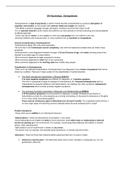Summary
Summary AQA A-Level Psychology Schizophrenia Notes
- Course
- Institution
AQA A-Level Psychology Schizophrenia Notes - summarised using all the relevant information, with key points and names in bold. Evaluations are clearly marked as + / - which allows for these notes too easily be converted into essay plans. Learning these notes achieved me an A*.
[Show more]



